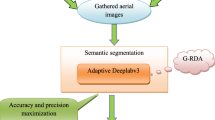Abstract
Conservation efforts in remote areas, such as population monitoring, are expensive and laborious. Recent advances in satellite resolution have made it possible to achieve sub-40 cm resolution and see small objects. This study aimed to count potential southern royal albatross nests based on the remote Campbell Island, 700 km south of New Zealand. The southern royal albatross population is declining, and due to its remoteness, there is an urgent need to develop new remote sensing methods for assessing the population. This paper proposes a new tree-based genetic programming (GP) approach for binary image segmentation by extracting shallow convolutional features. An ensemble of these GP segmentation models and individual GP models were compared with a state-of-the-art nnU-Net segmentation model trained on manually labelled images. The ensemble of shallow GP segmentation trees provided significantly more interpretable models, using <1% the number of convolutions while achieving performance similar to that of the nnU-Net models. Overall, the GP ensemble achieved a per-pixel F1 score of 75.44% and 123 out of 166 correctly identified nest-like points in the test set compared with the nnU-Net methods, which achieved a per-pixel F1 score of 74.49% and 129 out of 166 correctly identified nest-like points. This approach improves the practicality of machine learning and remote sensing for monitoring endangered species in hard-to-reach regions.
Access this chapter
Tax calculation will be finalised at checkout
Purchases are for personal use only
Similar content being viewed by others
References
Bi, Y., Xue, B., Zhang, M.: An evolutionary deep learning approach using genetic programming with convolution operators for image classification. In: 2019 IEEE Congress on Evolutionary Computation (CEC), pp. 3197–3204 (2019)
Bi, Y., Xue, B., Zhang, M.: Genetic programming with image-related operators and a flexible program structure for feature learning in image classification. IEEE Trans. Evol. Comput. 25(1), 87–101 (2021)
Bowler, E., Fretwell, P.T., French, G., Mackiewicz, M.: Using deep learning to count albatrosses from space: assessing results in light of ground truth uncertainty. Remote Sens. 12(12), 1–18 (2020)
Corbane, C., et al.: Remote sensing for mapping natural habitats and their conservation status - new opportunities and challenges. Int. J. Appl. Earth Obs. Geoinf. 37, 7–16 (2015). Special issue on earth observation for habitat mapping and biodiversity monitoring
Duporge, I., Isupova, O., Reece, S., Macdonald, D.W., Wang, T.: Using very-high-resolution satellite imagery and deep learning to detect and count African elephants in heterogeneous landscapes. Remote Sens. Ecol. Conserv. 7(3), 369–381 (2021)
Ferreira, A.C., et al.: Deep learning-based methods for individual recognition in small birds. Methods Ecol. Evol. 11(9), 1072–1085 (2020)
Fortin, F.A., Rainville, F.M.D., Gardner, M.A., Parizeau, M., Gagné, C.: DEAP: evolutionary algorithms made easy. J. Mach. Learn. Res. 13(70), 2171–2175 (2012)
Fretwell, P.T., Scofield, P., Phillips, R.A.: Using super-high resolution satellite imagery to census threatened albatrosses. Ibis 159(3), 481–490 (2017)
Hoffman-Hall, A., Loboda, T.V., Hall, J.V., Carroll, M.L., Chen, D.: Mapping remote rural settlements at 30 m spatial resolution using geospatial data-fusion. Remote Sens. Environ. 233, 1–19 (2019)
Isensee, F., Jaeger, P.F., Kohl, S.A.A., Petersen, J., Maier-Hein, K.H.: nnU-Net: a self-configuring method for deep learning-based biomedical image segmentation. Nat. Methods 18(2), 203–211 (2021)
Kanjir, U., Greidanus, H., Oštir, K.: Vessel detection and classification from spaceborne optical images: a literature survey. Remote Sens. Environ. 207, 1–26 (2018)
Marchant, S., Higgins, P., Ambrose, S.: Handbook of Australian, New Zealand & Antarctic Birds: Volume I, Ratites to Ducks, vol. 1. Oxford University Press, Oxford (1990)
Menghani, G.: Efficient deep learning: a survey on making deep learning models smaller, faster, and better. ACM Comput. Surv. 55(12), 1–37 (2023)
Minaee, S., Boykov, Y., Porikli, F., Plaza, A., Kehtarnavaz, N., Terzopoulos, D.: Image segmentation using deep learning: a survey. IEEE Trans. Pattern Anal. Mach. Intell. 44(7), 3523–3542 (2022)
Mischler, C., Wickes, C.: Campbell Island/Motu Ihupuku Seabird Research & Operation Endurance February 2023. POP2022-11 final report prepared for Conservation Services Programme. Department of Conservation (2023)
Montana, D.J.: Strongly typed genetic programming. Evol. Comput. 3, 199–230 (1995)
Moore, P.J.: Southern royal albatross on Campbell Island/Motu Ihupuku: solving a band injury problem and population survey, 2004–08. DOC research and development series, 333, Publishing Team, Department of Conservation, Wellington, New Zealand (2012)
Ronneberger, O., Fischer, P., Brox, T.: U-Net: convolutional networks for biomedical image segmentation. In: Navab, N., Hornegger, J., Wells, W.M., Frangi, A.F. (eds.) MICCAI 2015. LNCS, vol. 9351, pp. 234–241. Springer, Cham (2015). https://doi.org/10.1007/978-3-319-24574-4_28
Suganuma, M., Shirakawa, S., Nagao, T.: A genetic programming approach to designing convolutional neural network architectures (2017)
Westerskov, K.: The nesting habitat of the royal albatross on Campbell Island, vol. 6, pp. 16–20. New Zealand Ecological Society (1958)
Acknowledgments
We thank Kāi Tahu and Kaitiaki Rōpū ki Murihiku for allowing us to work on their taonga. We also thank DOC Murihiku for their logistical support.
Author information
Authors and Affiliations
Corresponding author
Editor information
Editors and Affiliations
Rights and permissions
Copyright information
© 2023 The Author(s), under exclusive license to Springer Nature Switzerland AG
About this paper
Cite this paper
Rogers, M. et al. (2023). Genetic Programming with Convolutional Operators for Albatross Nest Detection from Satellite Imaging. In: Blanc-Talon, J., Delmas, P., Philips, W., Scheunders, P. (eds) Advanced Concepts for Intelligent Vision Systems. ACIVS 2023. Lecture Notes in Computer Science, vol 14124. Springer, Cham. https://doi.org/10.1007/978-3-031-45382-3_24
Download citation
DOI: https://doi.org/10.1007/978-3-031-45382-3_24
Published:
Publisher Name: Springer, Cham
Print ISBN: 978-3-031-45381-6
Online ISBN: 978-3-031-45382-3
eBook Packages: Computer ScienceComputer Science (R0)




